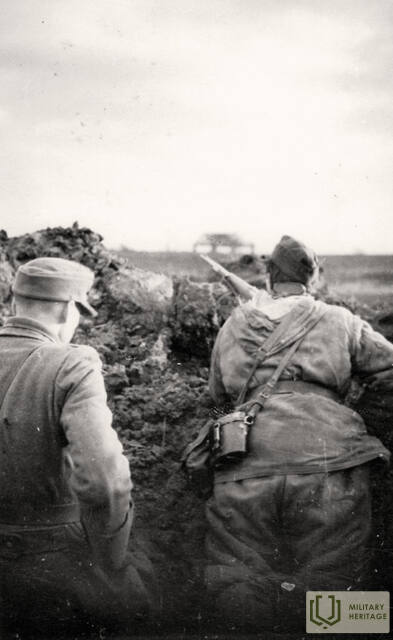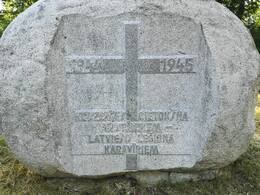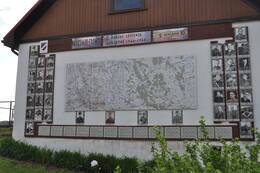Memories of Werner Preijers, commander of the company of the 42nd Regiment of the Latvian Legion, about the battles of Courland.
The Courland Fortress was formed after the fall of Riga on October 13, 1944, and the Russian breakthrough to Klaipėda on October 10, thus cutting off land traffic with Germany.
(..) The battles in Courland were so severe and often in unclear, complex conditions that when conducting each battle, one had to improvise, often taking risks, contrary to generally accepted principles of war. What worked in one battle did not work in another. Only one principle remained strict and unchanging – what is called soldier's morale. The entire Courland fortress, but our 19th in particular, as well as the 106th Grenadier Regiment, of course, also held to this principle. When I joined the Latvian army as a young man, among many other qualities necessary for a soldier, they mentioned morale and moral strength in the first place. It took some time until I fully understood what this complex of qualities really meant. This concept is not quite the same as what is understood by it in civilian life, or what Captain Līdums later describes as "pure and shameless" living, mentioning as an opposite, similar living, gluttony, gluttony and carnal desires. (..)
(..)We had a strict ammunition limit for a long time – 5 cartridges per machine gun. However, every machine gunner knows well that with 5 cartridges it is difficult to check whether the machine gun is working, as is often done when posts change. It was not that we did not have ammunition stored for critical moments. Serious officers told me that in general the ammunition in Kurzeme was enough for a month or a little longer. However, clear reason showed that the end was not far off, although we had decided to fight to the end, then we will see. The only thing that pleased the German lieutenant in Sarum was that he and, I think, others also trusted us – the Latvians. In fact, there was something to rely on, and this 6th major battle, one of the most difficult battles in Courland, as Lieutenant Colonel Kociņš said, was won by us, the last Courland legionnaires, the last of the 19th.(..)
Related timeline
Related objects
Memorial Stone to Defenders of the Kurzeme Fortification
Located in Tukums region, on the side of the A9 highway, 500 m from the turnoff to Lesteni in the direction of Riga.
The memorial was established in 1991 near the Rumbu houses, which were the scene of active hostilities. It is a tribute to the defenders of the “Courland Fortress” who fought against the Red Army in World War II. The battles were significant because they temporarily halted the Red Army’s complete occupation of Latvia. Approximately 300,000 Latvians emigrated to escape the crimes committed against civilians by the Soviet regime.
At the end of World War II, a peculiar situation had developed in the territory of Latvia. German army forces were located in Courland, which the Red Army tried to eliminate or prevent from being involved in battles in East Prussia or around Berlin. “Courland Fortress” is the most common term used to describe the hostilities in Courland from 1944 to 1945. “The Battle of Courland” was the German army’s fight to repel the Red Army’s massive attacks. The Courland Fortress ceased to exist shortly after Germany’s capitulation.
Today, you can visit the memorial and resting place, which was popular among Latvian legionnaires since the restoration of Latvia's independence.
Lestene Brothers' Cemetery
Located in Tukums region, Lestene, next to the church.
The creation of the mass grave in Lestene began in 1998. It is the second largest military cemetery in Latvia, where more than 1,300 Latvian legionnaires are buried. Only after the restoration of the Republic of Latvia was it possible to rebury Latvian soldiers who fell in World War II from various places.
The Latvian Legion was a combat unit of the German army, formed mainly from illegally mobilized Latvian residents. The soldiers perceived their presence in the legion as a fight for the restoration of Latvian independence, despite the fact that it took place within the ranks of the German armed forces and Germany had occupied Latvia. There was no other military force that could delay the return of the Soviet occupation. The Latvian legionnaires fought against the Red Army, which had liquidated the independence of Latvia, destroyed its army and committed crimes against the civilian population. About 110,000–115,000 soldiers fought in the ranks of the German army, about 30,000–50,000 of them lost their lives on the battlefields.
Nowadays, in Lestene you can visit the Brothers' Grave, next to which is the Lestene Church. It is an outstanding example of Baroque sacred art. In the ancient church tavern you can get acquainted with an exhibition dedicated to the history of the Latvian Legion. The central image of the brothers' grave, "Homeland - Mother - Latvia", was created by sculptor Arta Dumpe. Nearby is the Lestene Manor, which belonged to Latvian Army General Mārtiņš Hartmanis before World War II.
Tours of the Lestene Church can be booked with the parish priest of the Lestene Evangelical Lutheran Church, Inguna Kokina, phone +371 29993743.
Lestene Brothers' Cemetery, Memorial Exposition and bunker
Lestene Brothers’ Cemetery is located in Tukums municipality, Lestene, next to the Lestene church. The construction of the Brothers’ Cemetery in Lestene began in 1998. It is the second largest military cemetery in Latvia, and more than 1,300 Latvian legionnaires are buried here. Only after regaining the independence, it was possible to rebury Latvian soldiers who fell during World War II. The Latvian Legion was a combat unit of the German Army, formed mainly from illegally drafted Latvians. The soldiers thought of their presence in the legion as something that had to be done to be able to restore Latvia’s independence, despite the fact that they were in the ranks of the German armed forces and that Germany had occupied Latvia. Latvian legionnaires fought against the Red Army, which had destroyed Latvia's independence and its army and committed crimes against civilians. Between 110,000 and 115,000 soldiers fought in the ranks of the German Army and about 30,000–50,000 of them never left the battlefield. The Brothers’ Cemetery central theme ‘Motherland – Mother – Latvia’ was created by the sculptor Arta Dumpe. Across the road an exhibit dedicated to the history of the Latvian Legion has been created in a former pub. Right next to it the men of the Latvian Officers Association, under the leadership of Captain Jānis Slaidiņš, have built an underground bunker to show how soldiers and officers lived on the front lines.
Kurzeme fortress museum in Zante
Will be open from May 1st.










